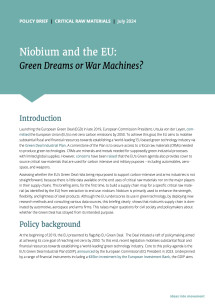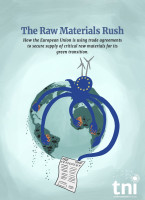Niobium and the EU Green Dreams or War Machines?
Regions
In late 2019, European Commission President Ursula von der Leyen launched the European Green Deal, aiming for net-zero carbon emissions by 2050. The EU’s Green Deal Industrial Plan seeks to establish a leading green technology industry by securing critical raw materials (CRMs) necessary for green technologies. However, concerns arise that the EU’s green agenda might mask the sourcing of CRMs for carbon-intensive and military purposes. This briefing reveals niobium’s supply chain, primarily serving the automotive, aerospace, and arms industries, questioning whether the Green Deal’s goals are compromised. Are we truly advancing green technology, or inadvertently fuelling traditional industries?

Downloads
Authors
Introduction
Launching the European Green Deal (EGD) in late 2019, European Commission President, Ursula von der Leyen, committed the European Union (EU) to net-zero carbon emissions by 2050. To achieve this goal, the EU aims to mobilise substantial fiscal and financial resources towards establishing a ‘world-leading’ EU-based green technology industry via the Green Deal Industrial Plan. A cornerstone of the Plan is to secure access to critical raw materials (CRMs) needed to produce green technologies. CRMs are minerals and metals needed for supposedly green industrial processes with limited global supplies. However, concerns have been raised that the EU’s Green agenda also provides cover to source critical raw materials that are used for carbon intensive and military puposes – including automobiles, aerospace, and weapons.
Assessing whether the EU’s Green Deal risks being repurposed to support carbon-intensive and arms industries is not straightforward, because there is little data available on the end uses of critical raw materials nor on the major players in their supply chains. This briefing aims, for the first time, to build a supply chain map for a specific critical raw material (as identified by the EU) from extraction to end use: niobium. Niobium is primarily used to enhance the strength, flexibility, and lightness of steel products. Although the EU underscores its use in green technology, by deploying new research methods and consulting various data sources, this briefing clearly shows that niobium’s supply chain is dominated by automotive, aerospace and arms firms. This raises major questions for civil society and policymakers about whether the Green Deal has strayed from its intended purpose.






